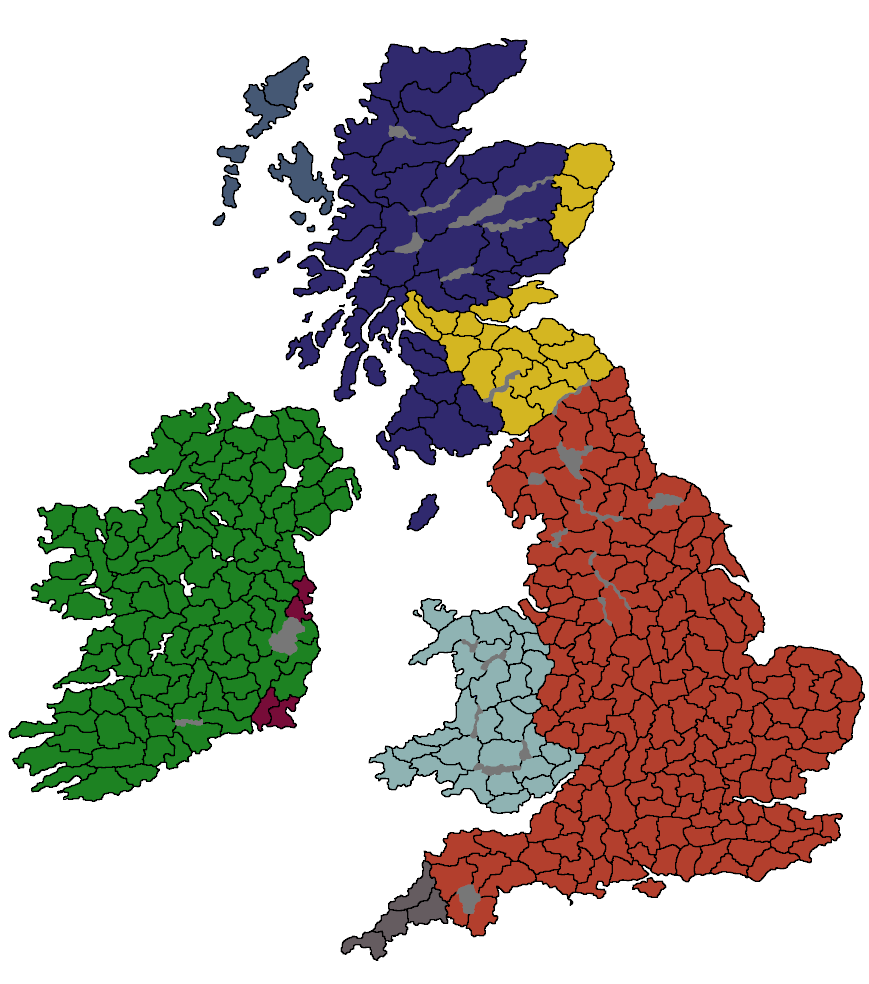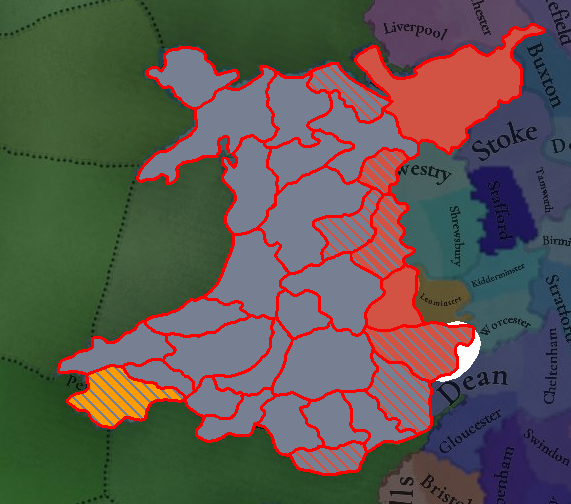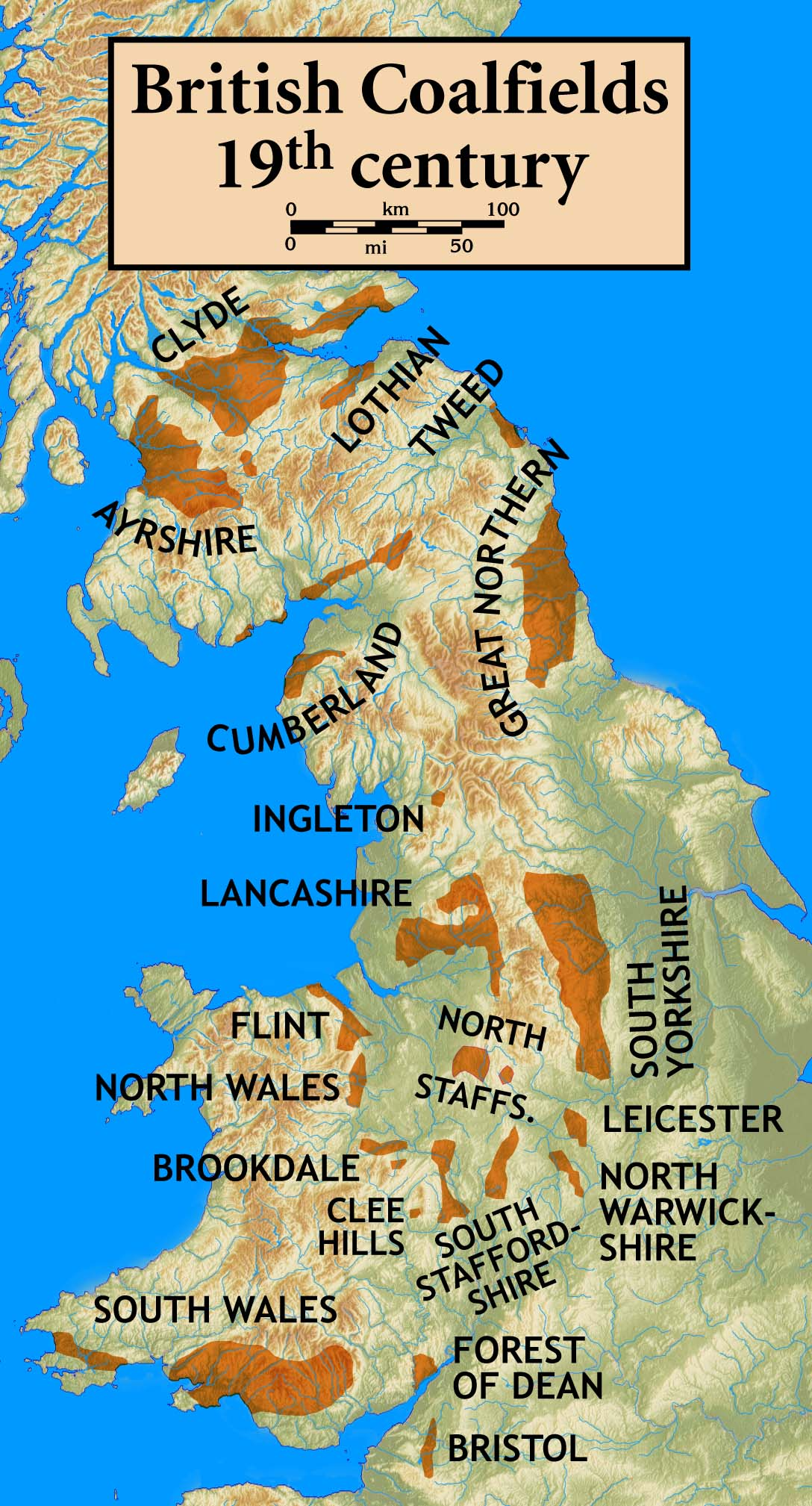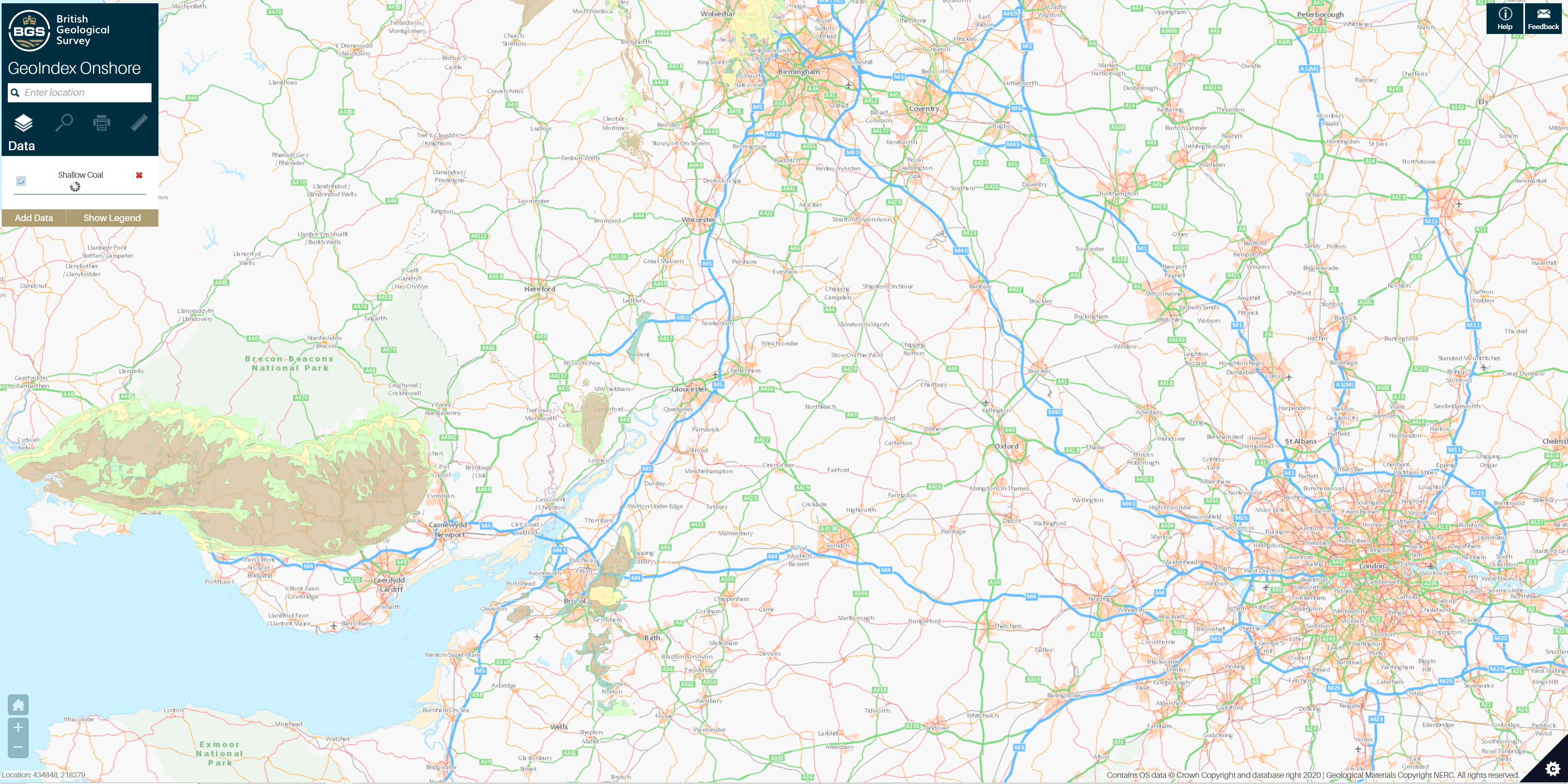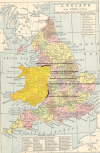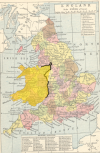Hello everyone. @Pavía and the rest of the Content Design team are busy working on the feedback for the previous Tinto Maps, so I'm standing in for this week.
I'm @SaintDaveUK, some of you might have seen me here and there on the forums, but the long story short is that I work on a very secret game whose name I am contractually obligated to redact. That's right, it's ███████ ██████!
This week you get a double-whammy, mostly because it’s really hard to show Britain on its own on a screenshot. Partly to side-step the “British Isles” naming controversy, but mainly because the gameplay of them both is so different, this part of Europa is divided into 2 distinct regions: Great Britain and Ireland.

We would like to add some more impassable locations in northern England and the Scottish borders to make manoeuvres a little more interesting and strategic, but would like suggestions from people more familiar with the Pennines.
[Edit: 16 June added the missing map]


The further north-west we go, the less fertile the terrain, and as such the greater reliance on pastoral farming such as livestock over wheat. The western hills and valleys also expose a greater number of mineral delights, including the historic stannary mines of Devon and Cornwall.

They are both shades of red because they are coloured after the market centre’s top overlord country – market control is a viable playstyle and we like to think of it as a form of map painting for countries not focused on traditional conquest routes.

Scotland, conversely, is a real porridge of cultures. The Lowland Scots (who speak a dialect of Northumbrian English that later develops into the Scots language) dominate their kingdom from their wealthy burghs, and are gradually encroaching onto the pastoral lands of the Gaelic Highlanders. The Norse-Gaelic clansmen watch from the Western Isles, with some old settlements remaining around Galloway. The far north, ironically called Sutherland, retains some Norse presence.
Wales, conquered for around a century by this point, plays host to English burghers looking to make a few quid, as well as the descendants of Norman adventurer knights in the marcher lordships, but is still majority Welsh-speaking from Anglesey to Cardiff.
The Anglo-Irish (representing the spectrum from Cambro-Norman knights to the so-called ‘Old English’ settlers) live in great numbers in the south-eastern trading towns from Dublin to Cork, as well as in smaller numbers in frontier outposts.
The cosmopolitan towns across the isles are also home to people from elsewhere in Europe, most notably Flemish weavers from the Low Countries, though their numbers are too small to impact the mapmode.
The Norman ███████ dominates as the ██████████████ for both of the kingdoms and their subjects. The conquest of 1066 is no longer fresh, but the continuing bonds between the aristocratic classes of England, Scotland, and France have kept the French language alive and strong.

Other than that, it's all Catholic. But not for long.
> John Wycliffe has entered the chat.

We’ve almost certainly offended someone.
The ancient Scottish shires are pretty messy and difficult to coalesce into neat provinces, so any suggestions for better arrangement there would be very welcome.

You might notice that the locations in Ireland are varyingly written in both English and in Irish. This is because we have the new system up-and-running where we can name Locations by the primary culture of the country they are owned by.
This means that for example London might be called Londres if it was ruled by a Catalan country. It’s currently a WIP feature and we might add more elements, such as a game setting to base the name on dominant culture of the location instead, or to just use default (English) names.


The powerful Burgesses estate in the City of London enjoys ancient freedoms from royal power, while the king peers in from the Crown’s seat of power in neighbouring Westminster.
The County Palatine of Durham is not represented by a country, but buildings that give the Clergy Estate a huge amount of power in the locations it is present in. This also ties into political gameplay as a ██████████ ██████.
The newly created Duchy of Cornwall—the only duchy in England at the time—would also not be represented well by the Cornwall country, being a disparate set of manorial holdings that are ironically mostly in Devon. Cornwall of course exists as a releasable country though.
The Isle of Man is a little less certain. For now we have it as a subject of England. On paper it was a ‘kingdom’ awarded to William Montagu, the king’s favourite, however we aren’t sure if he actually wielded any real power on the isle. It changed hands between England and Scotland numerous times in this period, but in practice it appears to have been governed by a local council of barons. Any more details on exactly what was going on here in this period would be greatly appreciated.
These decisions have been made because as England heaves itself out of the feudal system, we thought it would be best if the small-fry inward-looking internal politicking is handled through the Estates and [redacted] systems, and then the diplomacy tracks are freed up for the English player to behave more outwardly against other major countries.
Those familiar with Welsh history will note that historically the Principality of Wales didn’t extend much beyond the old kingdom of Gywnedd. Much of the country to the southeast was in fact ruled by marcher lords, which we represent with a powerful Nobility estate in the valleys and beyond.
There is an alternative vision of Wales that I would like to gauge opinion on, and that is expanding it to include the Earldom of Chester and the marches on the English side of the modern border. If you are an Englishman familiar with modern borders this might look alarming, but these lands were also constitutionally ambiguous parts of the “Welsh Marches” until the 1500s. This will hand over to the Wales player the full responsibility of dealing with the marcher lords, allowing England to focus on bigger picture issues like beating France.
The Tanistry system of succession endemic to the Gaelic Irish has its advantages, but it can also lead to chaotic feuds between rival branches. The so-called Burke Civil War has fractured the powerful Earldom of Ulster into rival Burke cousins who jealously feud over their shrinking lordships in Connaught. Native Irish princes of the north have reconquered most of their own lands from the de Burghs, but there are also two rival O’Neill cousins who style themselves King of Tyrone either side of the River Bann.
The feuding Irish lack a unifying figure, but anyone powerful enough could theoretically claim the title of High King. The former provincial kingdoms, such as Meath and Connacht, enjoy the elevated rank of Duchy, giving them a slight edge in the High Kingship selection.
Meanwhile, Scotland’s canny regent Sir Andrew de Moray launches his decisive counterattack as his true king, David II de Bruce, waits in exile in France.




Well, thats it for now!
As always the team is eagerly awaiting your feedback and looking forward to the discussions. We’ll try to keep on top of the thread, but we have a teambuilding activity this afternoon so it might be a little more sporadic than usual!
Next week: Anatolia!
I'm @SaintDaveUK, some of you might have seen me here and there on the forums, but the long story short is that I work on a very secret game whose name I am contractually obligated to redact. That's right, it's ███████ ██████!
This week you get a double-whammy, mostly because it’s really hard to show Britain on its own on a screenshot. Partly to side-step the “British Isles” naming controversy, but mainly because the gameplay of them both is so different, this part of Europa is divided into 2 distinct regions: Great Britain and Ireland.
Climate
The mild Oceanic climate (Köppen Cfb) dominates the isles. Where it cools towards the inland Pennines and the Scottish Highlands (Köppen Cfc), we represent it with the wintry and dreich Continental climate.
Topography
The isles are dominated by green and pleasant flatlands and low rolling hills, the peripheries punctuated by rocky mountains and craggy highlands.We would like to add some more impassable locations in northern England and the Scottish borders to make manoeuvres a little more interesting and strategic, but would like suggestions from people more familiar with the Pennines.
[Edit: 16 June added the missing map]
Vegetation
The great moors, bogs, and fens are represented by Sparse vegetation, meanwhile much of the land is still wooded.
Raw Materials
The raw goods situation aims to reflect the economic reality of medieval Britain. Shepherding was common on every corner of the islands, a lot of the wool produced was sold to the industrial hub of the Low Countries to be manufactured into cloth, which was in turn sold back to British markets.The further north-west we go, the less fertile the terrain, and as such the greater reliance on pastoral farming such as livestock over wheat. The western hills and valleys also expose a greater number of mineral delights, including the historic stannary mines of Devon and Cornwall.

Markets
As you can see the two starting markets are London and Dublin. Aside from London we could have chosen almost any town, from Aberdeen to Bristol. We chose Dublin as it was the main trade centre in Ireland, and also because it handsomely splits the isles to the East and West of the Pennines, demonstrating the impact that terrain can have on dynamic Market attraction.They are both shades of red because they are coloured after the market centre’s top overlord country – market control is a viable playstyle and we like to think of it as a form of map painting for countries not focused on traditional conquest routes.

Culture
We have decided to go with a monolithic English culture. We could have forced the introduction of a second Northumbrian or even third Mercian culture, but typically they were not really considered separate peoples. The English, though diverse in origin and with a variety of dialects, had already begun to coalesce in the face of the Viking invasions hundreds of years before.Scotland, conversely, is a real porridge of cultures. The Lowland Scots (who speak a dialect of Northumbrian English that later develops into the Scots language) dominate their kingdom from their wealthy burghs, and are gradually encroaching onto the pastoral lands of the Gaelic Highlanders. The Norse-Gaelic clansmen watch from the Western Isles, with some old settlements remaining around Galloway. The far north, ironically called Sutherland, retains some Norse presence.
Wales, conquered for around a century by this point, plays host to English burghers looking to make a few quid, as well as the descendants of Norman adventurer knights in the marcher lordships, but is still majority Welsh-speaking from Anglesey to Cardiff.
The Anglo-Irish (representing the spectrum from Cambro-Norman knights to the so-called ‘Old English’ settlers) live in great numbers in the south-eastern trading towns from Dublin to Cork, as well as in smaller numbers in frontier outposts.
The cosmopolitan towns across the isles are also home to people from elsewhere in Europe, most notably Flemish weavers from the Low Countries, though their numbers are too small to impact the mapmode.
The Norman ███████ dominates as the ██████████████ for both of the kingdoms and their subjects. The conquest of 1066 is no longer fresh, but the continuing bonds between the aristocratic classes of England, Scotland, and France have kept the French language alive and strong.

Religion
I decided that it's not even worth taking a screenshot of the Religion map mode. There are tiny minorities of Jewish people in some Scottish and Irish towns (they had been expelled from England), but they are so small in number they don't even register on the map modeOther than that, it's all Catholic. But not for long.
> John Wycliffe has entered the chat.
Areas
Based on the 4 provinces of Ireland (sorry Meath) and splitting England roughly into the larger Anglo-Saxon earldoms which have some similarity with the modern Regions (sorry Yorkshire).
Provinces
We have fixed the colours of the Provinces mapmode so you can see the individual provinces a bit more clearly. These are largely based on the historic counties, which have remained fairly constant throughout history, while merging some of those that are too small.We’ve almost certainly offended someone.
The ancient Scottish shires are pretty messy and difficult to coalesce into neat provinces, so any suggestions for better arrangement there would be very welcome.

Locations
You might notice that the locations in Ireland are varyingly written in both English and in Irish. This is because we have the new system up-and-running where we can name Locations by the primary culture of the country they are owned by.
This means that for example London might be called Londres if it was ruled by a Catalan country. It’s currently a WIP feature and we might add more elements, such as a game setting to base the name on dominant culture of the location instead, or to just use default (English) names.

Government Types
As with most of Europe, most of the countries are under some monarchy or another, but the Irish tuathas begin with the Tribe government type. This, among other mechanics such as [redacted] helps to give them a very unique playing style in Europe.
Countries
England
England of course stands as the dominant kingdom in the isles. Despite having a lot of power resting on the barons, the country is fairly unitary even at this point, with very little practical separation between the crown’s power in somewhere like Kent versus Yorkshire. However there are notable exceptions.The powerful Burgesses estate in the City of London enjoys ancient freedoms from royal power, while the king peers in from the Crown’s seat of power in neighbouring Westminster.
The County Palatine of Durham is not represented by a country, but buildings that give the Clergy Estate a huge amount of power in the locations it is present in. This also ties into political gameplay as a ██████████ ██████.
The newly created Duchy of Cornwall—the only duchy in England at the time—would also not be represented well by the Cornwall country, being a disparate set of manorial holdings that are ironically mostly in Devon. Cornwall of course exists as a releasable country though.
The Isle of Man is a little less certain. For now we have it as a subject of England. On paper it was a ‘kingdom’ awarded to William Montagu, the king’s favourite, however we aren’t sure if he actually wielded any real power on the isle. It changed hands between England and Scotland numerous times in this period, but in practice it appears to have been governed by a local council of barons. Any more details on exactly what was going on here in this period would be greatly appreciated.
These decisions have been made because as England heaves itself out of the feudal system, we thought it would be best if the small-fry inward-looking internal politicking is handled through the Estates and [redacted] systems, and then the diplomacy tracks are freed up for the English player to behave more outwardly against other major countries.
Wales
Though subjugated by conquest, Wales was not formally annexed into the Kingdom of England until the mid 1500s. As such the principality begins as a Dominion subject under England.Those familiar with Welsh history will note that historically the Principality of Wales didn’t extend much beyond the old kingdom of Gywnedd. Much of the country to the southeast was in fact ruled by marcher lords, which we represent with a powerful Nobility estate in the valleys and beyond.
There is an alternative vision of Wales that I would like to gauge opinion on, and that is expanding it to include the Earldom of Chester and the marches on the English side of the modern border. If you are an Englishman familiar with modern borders this might look alarming, but these lands were also constitutionally ambiguous parts of the “Welsh Marches” until the 1500s. This will hand over to the Wales player the full responsibility of dealing with the marcher lords, allowing England to focus on bigger picture issues like beating France.
Ireland
Ireland is going through a moment of change. English royal power is centred on the Lordship of the Pale, the king’s Dominion ruling out of Dublin Castle. However, it struggles to keep a grasp on the rebellious Hiberno-Norman earls scattered around the island - some of whom remain as vassals, some of whom have managed to slip free of royal control.The Tanistry system of succession endemic to the Gaelic Irish has its advantages, but it can also lead to chaotic feuds between rival branches. The so-called Burke Civil War has fractured the powerful Earldom of Ulster into rival Burke cousins who jealously feud over their shrinking lordships in Connaught. Native Irish princes of the north have reconquered most of their own lands from the de Burghs, but there are also two rival O’Neill cousins who style themselves King of Tyrone either side of the River Bann.
The feuding Irish lack a unifying figure, but anyone powerful enough could theoretically claim the title of High King. The former provincial kingdoms, such as Meath and Connacht, enjoy the elevated rank of Duchy, giving them a slight edge in the High Kingship selection.
Scotland
The chancer Edward Balliol continues his attempt for the Scottish throne, with England’s tacit permission. It’s hard to determine the exact lands held by Balliol in 1337, but we know his disinherited loyalists hold the castle of Perth while his English allies had seized large tracts of the lowlands from Bruce. Balliol has also bought the loyalty of the MacDonald and the other Hebridean galley lords by granting them remote land on the west coast of the mainland.Meanwhile, Scotland’s canny regent Sir Andrew de Moray launches his decisive counterattack as his true king, David II de Bruce, waits in exile in France.

Dynasties
We know about Plantagenet, Balliol, and Bruce, so I've zoomed in on Ireland to show the ruling dynasties of the various chieftains and earls.
Population
Excuse the seams and the greyscale mapmode. We have something better in the pipeline...

Well, thats it for now!
As always the team is eagerly awaiting your feedback and looking forward to the discussions. We’ll try to keep on top of the thread, but we have a teambuilding activity this afternoon so it might be a little more sporadic than usual!
Next week: Anatolia!



